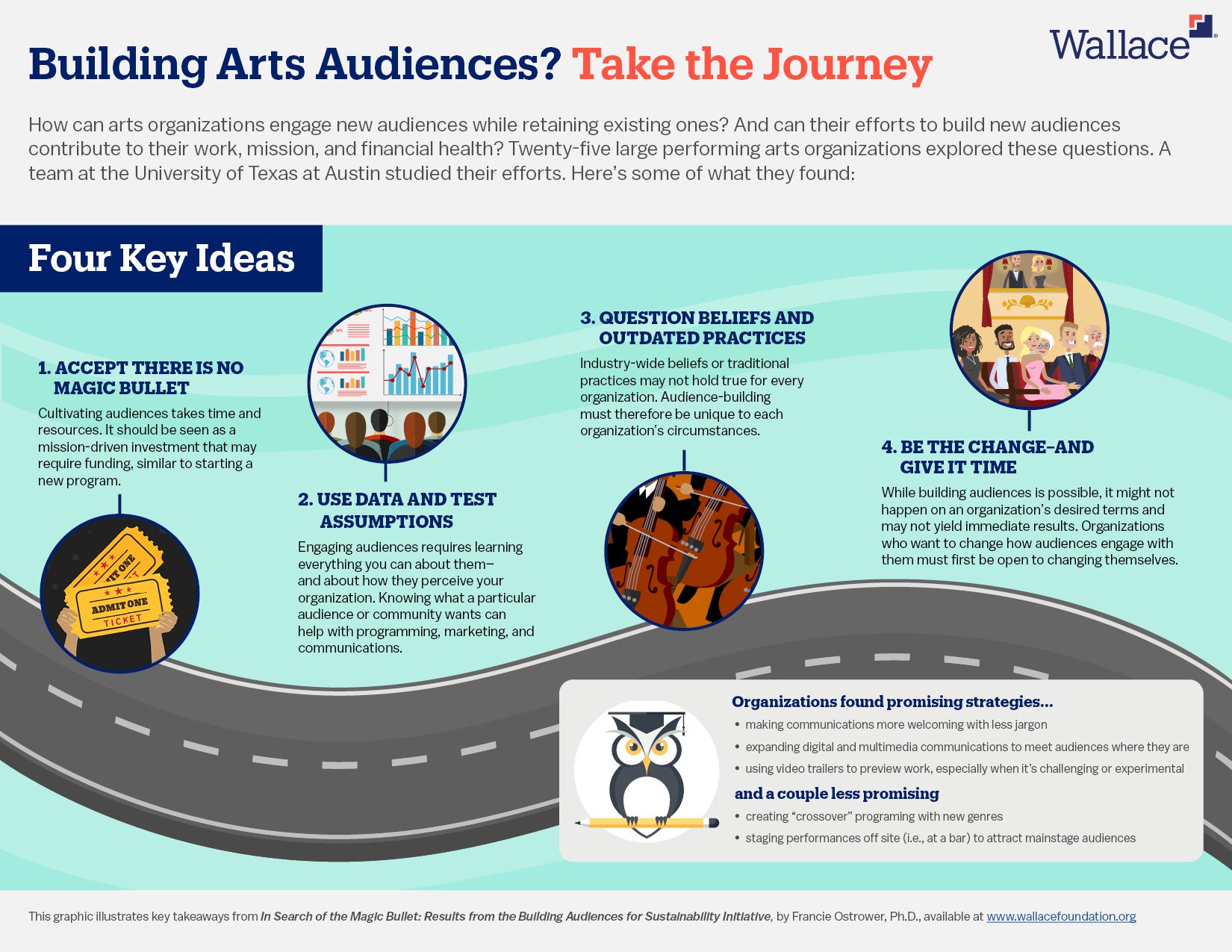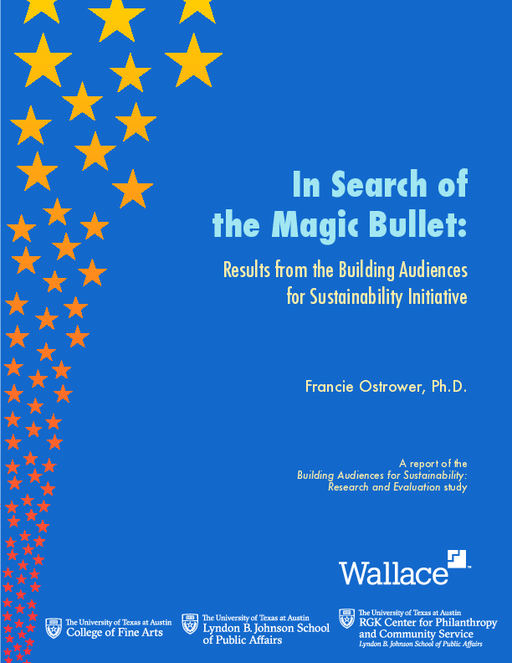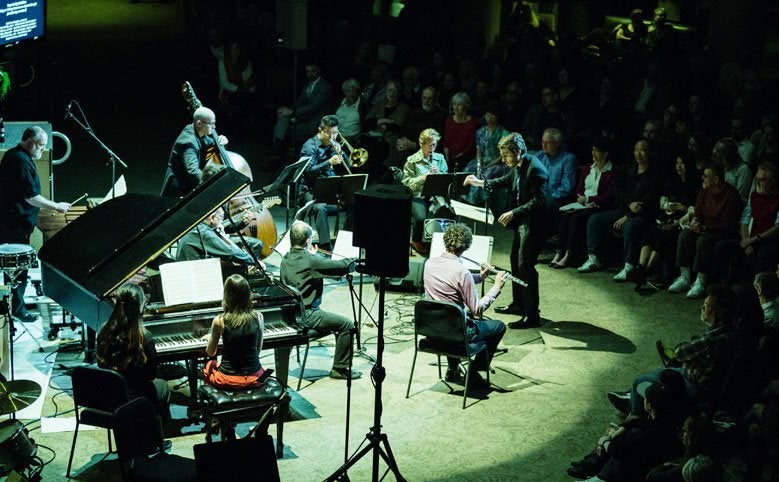Breadcrumb
- Wallace
- Reports
- In Search Of The Magic Bullet Re...
In Search of the Magic Bullet
Results from the Building Audiences for Sustainability Initiative

- Author(s)
- Francie Ostrower, Ph.D.
- Publisher(s)
- The University of Texas at Austin
Summary
How we did this
The research team conducted three major data collection efforts between 2015 and 2022. These efforts included: 1) Conducting 301 interviews with arts leaders and staff between 2015 and 2022; 2) Compiling data from organizational ticket-bases for a subset of 15 organizations; and 3) Collecting and analyzing data for those 15 organizations from online audience surveys in 2015 and 2019.
There is no magic bullet for arts organizations looking to build their audiences while also increasing revenue. While it’s possible to engage both new and current audiences using a variety of strategies, successful audience building may not always happen on the organization’s desired terms. It also might not bring the hoped-for financial gains, at least not right away.
That’s one of several key learnings from the nonprofit performing arts organizations who participated in Wallace’s Building Audiences for Sustainability (BAS) initiative from 2015 to 2019.
The 25 organizations tested different approaches to build new audiences while keeping their current audiences engaged. Some focused on age groups, such as millennials or Gen-X; others looked at location and how they interacted with their community. Some worked to attract a more racially or ethnically diverse audience. A few sought to build audiences for new or less familiar works.
What worked?
To find out which approaches worked and which were less successful, researchers from the University of Texas at Austin drew on extensive interviews with BAS organizations’ leadership and staff. They also looked at ticketing data and audience surveys for a subset of 15 BAS organizations. Notably, most of this subset were able to expand their target audience. Increases, however, were often more modest than initially hoped-for gains, and did not result in an overall growth in attendance.
Researchers learned that some audience-building approaches were more effective than others. Many organizations discovered that changing how they communicated about programming with prospective audiences made a difference. In publicizing new work, for example, one organization learned that “world premieres” held little cachet for the audience they sought to reach. Providing audiences with a sense of what to expect from the performance, however, was impactful.
Changing how program information was delivered to audiences also made a difference: expanding use of digital communications (email, social media, video) to share important and informative content was consistently effective.
What fell short?
Other audience-building approaches often did not work as anticipated. For example, the results of “crossover strategies"–when organizations presented different types of programs specifically to attract new audiences with the hope that these audiences would then attend traditional programming–were consistently disappointing. This led many organizations to question the myth of what one interviewee described as the “long, slow escalator,” a long-held theory that audience members slowly progress from a first visit to more frequent attendance to ultimately becoming subscribers and donors.
And some approaches produced mixed results. For example, organizations had varied success using performances at off-site venues to attract new audiences to mainstage productions.

If organizations want to change audience engagement with them, then organizations need to be open to changing themselves.
What are the implications?
Audience building is hard work. Organizations should determine their goal at the outset. Is it, for example, to expand audiences, even if it involves changing or expanding their programming? Or is the goal to build audiences strictly for what they already do? Each requires a different focus and strategies.
All of the BAS organizations used data and market research to understand what worked and what didn’t. The data helped them understand and revise long-held assumptions about their particular audiences. It helped them better connect and communicate with new audiences as well.
Using data also highlighted the pitfalls of advocating for approaches without first assessing costs and benefits. It steered some organizations away from judging success based on a single effort. And it helped underscore that there may be mission-driven reasons for pursuing a particular audience that might not boost finances and, in fact, might even require additional investment.
This final report explores these and other audience-building approaches that BAS organizations employed, as well as the financial implications of these efforts. Perhaps the most unexpected lesson for participating organizations was that audience building doesn’t depend on the audience alone. If arts organizations want to change how they engage with their audiences, they may first need to be open to changing themselves.
Key Takeaways
- Most BAS organizations expanded their target audience, although changes were often more modest than initially hoped-for gains and generally did not increase overall attendance, at least in the short-term.
- Unexamined and unfounded assumptions often hindered organizations’ ability to connect with audiences they hoped to reach. Using data helped organizations uncover these assumptions.
- Successful audience-building strategies met audiences where they were. For example, using more welcoming and informative communication styles and expanding the use of digital and multimedia platforms usually worked.
- Offering unique programming specifically to attract new audiences, as well as presenting at off-site venues with the hope that these audiences would “crossover” to attend traditional programs were consistently ineffective.
- Over the course of the initiative, organizations saw overall audience gains, coupled with fewer subscribers and a decline in frequency of attendance. This suggests that organizations might need to attract and embrace more infrequent audience members and/or find ways to cultivate deeper engagement with audiences.
- Targeted audience building does not necessarily predict growth in earned revenue. Organizations should acknowledge that some audience-building efforts require financial subsidy and serve other important needs that aren’t tied to financial health.
Watch Organizations at Work
Materials & Downloads
Audience Building: Four Key Ideas
Graphic highlights ways to help organizations think about attracting and retaining audiences

What We Don't Know
- This study was conducted with 25 large and well-established nonprofit arts organizations. How do these lessons apply for smaller, less well-established arts organizations?
- The report describes long-term trends that preceded and were often exacerbated by the pandemic. Post pandemic interviews suggested that the urgency of the pandemic has not yet yielded new solutions to long-term challenges. What does that mean for audience engagement now?











